Project Amethyst: Peeking Behind the Curtain of PlayStation’s Next-Gen Graphics
The gaming world is buzzing, and for good reason! Sony, in collaboration with AMD, has just offered us a tantalizing glimpse into the future of PlayStation. In a recent nine-minute video, Mark Cerny, the mastermind behind the PlayStation 4 and PlayStation 5, sat down with Jack Huynh, AMD’s Senior Vice President and General Manager of their Computing and Graphics Group. Their discussion centered around a groundbreaking initiative dubbed “Project Amethyst,” a collection of technologies poised to redefine what’s possible in console gaming graphics.
While these advancements currently exist only in simulations, Cerny’s insights confirm what many have suspected: the next PlayStation is gearing up to significantly enhance ray tracing, upscaling, and other machine learning-based rendering techniques. This isn’t just about faster frame rates; it’s about pushing the boundaries of visual fidelity and immersive experiences. Let’s dive into what we know about Project Amethyst and what it means for the future of gaming.
The Architecture of Tomorrow: Understanding Project Amethyst’s Core Tenets
Project Amethyst isn’t a single feature; it’s a holistic approach to next-generation graphics. Cerny explicitly mentioned a triad of key areas set for significant upgrades: ray tracing, upscaling, and machine learning-based rendering. These aren’t new concepts in themselves, but the way Sony and AMD are integrating and optimizing them promises a leap forward.
Ray tracing, for example, is already present in current-gen consoles, but often comes with performance compromises. Project Amethyst aims to mitigate these, offering more realistic lighting, shadows, and reflections without sacrificing precious frames. Imagine game worlds where every light source interacts with the environment with stunning accuracy, creating unparalleled immersion.
Upscaling, particularly those powered by machine learning (like AMD’s FSR or NVIDIA’s DLSS), has become crucial for achieving high resolutions at playable frame rates. The advancements teased suggest a far more sophisticated and robust upscaling solution, perhaps one even more deeply integrated into the GPU architecture itself. This could mean sharper images, more detail, and a less noticeable upscaling “artifact” than what we see today.
Beyond Raw Power: The Role of Machine Learning in Graphics
The emphasis on “machine learning-based rendering techniques” is perhaps the most intriguing aspect of Project Amethyst. This signifies a departure from purely brute-force rendering and a move towards intelligent, AI-driven graphics pipelines. Machine learning can be applied to a vast array of rendering challenges, from optimizing geometry and textures to predicting and filling in missing detail.
For instance, imagine an AI that can intelligently de-noise ray-traced images in real-time, or one that can predict player movement to pre-load assets more efficiently. Such advancements could lead to significantly more complex and detailed game worlds without overburdening the system’s resources. This is where the true innovation lies – not just in how many polygons can be rendered, but in how intelligently they can be rendered.
Another potential application of machine learning could be in dynamic resolution scaling that’s far more intelligent than current implementations. Instead of simply lowering resolution uniformly, an AI could identify areas where resolution drops are least noticeable to the player, maintaining visual fidelity where it matters most. This level of granular control could deliver a consistently smooth and beautiful experience.
What This Means for AMD’s Future GPUs and the Gaming Landscape
The collaboration on Project Amethyst has significant implications not just for PlayStation, but for AMD’s broader GPU strategy. The technologies developed for the next PlayStation are highly likely to trickle down into AMD’s consumer graphics cards. This means PC gamers could also benefit from these advanced ray tracing, upscaling, and AI rendering capabilities.
This partnership also reinforces AMD’s strong position in the console market, once again placing them at the forefront of gaming innovation. As Cerny noted, these technologies “only exist in simulations” right now, implying that they are pushing the boundaries of what’s currently feasible. This close collaboration allows for co-development where hardware and software are designed in tandem, leading to highly optimized and efficient solutions. This is where the magic happens, ensuring that every transistor and every line of code works in perfect harmony.
Furthermore, the focus on machine learning in rendering suggests a future where GPUs are not just about processing power, but also about intelligence. This could lead to new avenues for graphics innovation, allowing developers to create increasingly ambitious and visually stunning games that were once thought impossible.
The Road Ahead: Anticipating the Next-Gen Console Experience
While the details remain sparse and the timeframe for the next PlayStation is still a mystery, Project Amethyst paints a promising picture. Players can anticipate a console experience that pushes visual realism to new heights, with more deeply immersive worlds, breathtaking lighting, and incredibly sharp visuals, even on high-resolution displays.
The marriage of Sony’s gaming vision with AMD’s cutting-edge silicon expertise is a formidable combination. As we move closer to the reveal of the next PlayStation, expect more details to emerge about these groundbreaking technologies.
One thing is clear: the future of PlayStation graphics is not just about incremental improvements, but about a fundamental shift in how games are rendered. Project Amethyst is an exciting harbinger of what’s to come, and we can’t wait to see these simulations brought to life!
